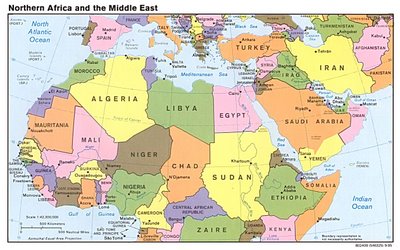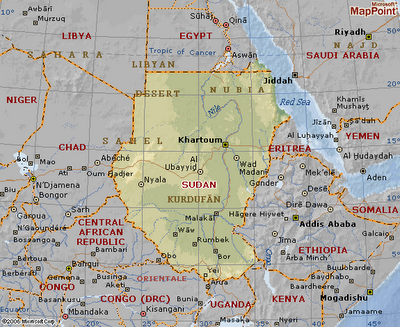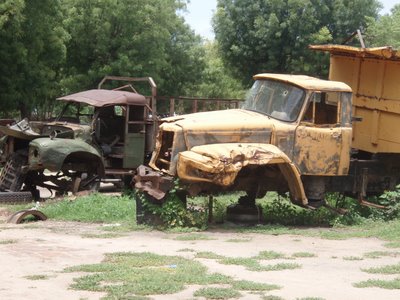Some History of Sudan - Background

Map of Central and North Africa
Today I will be posting some of the writing that I have been doing over the past few weeks about various aspects of Sudanese society and culture. I've included some maps and the photos which I hope will be helpful.
An Overview of Sudan – From Ancient Times until 1983.
Sudan is the largest country in Africa and is about the size of the entire United State east of the Mississippi. The name Sudan means “Land of the Blacks” in Arabic. Sudan shares its borders with 9 countries (Egypt, Libya, Chad, Central African Republic, Democratic Republic of Congo, Uganda, Kenya, Ethiopia and Eritrea), as well as the Red Sea. Today Sudan is made up of 19 ethnic groups (597 subgroups) and 134 languages are spoken - and 400 dialects.
There have probably been people living in Sudan for at least nine million years and there are some who claim that the Nile Valley may indeed be the cradle of civilization. What is ironic is that by 400 BC Sudan was a technological leader with its use of the ox-driven water wheel and that to this day this same device still plays an important role in Sudan’s economy.
Northern Sudan has various relationships with its northern neighbor Egypt for thousands of years. 3,000 years ago, Egypt colonized Nubia, the area in today’s northeastern Sudan. It was probably here that the practice of slavery in Sudan had its origins. (more on this in the Slavery section). I find it interesting that Nubia accepted Christianity in the 6th century and remained Christian until it was colonized by the Moslems in the 15th century.
In 1820, Egypt (as part of the Ottoman Empire) invaded Sudan and ruled until 1885. This was a period of internal unrest and the slave trade increased during this period. For three years, from 1877 – 1880 an ill-suited British general and administrator Charles Gordon served as governor of Egyptian Sudan. Seriously, don’t try to make sense of all of this. Gordon tried to end the slave trade, but was seriously overmatched and lost his life in the process. This was followed by the establishment of an Islamic state that unified this land, which for centuries had consisted of a number of independent nations.

Map of Sudan -
Look in the South for Yei and Bor. Juba is in between the two.
Britain ruled from 1899-1955. Britain understood that throughout its history Sudan has been divided along linguistic, racial, social, economic, and religious lines between the Arab north and the African south. As such, Britain established to separate administrations for the two regions.
On January 1, 1956, Sudan gained independence, though not before a rebellion against the rule from the north broke out in 1955. The Southerners, knowing that independence was coming were afraid that the newly independent nation would be dominated by the North. This civil war lasted until 1972.
An agreement was worked out giving the southerners more power and this led to an incredible ten years of peace.
The Second Civil War –1983 – 2005 - the one that one that is mentioned over and over again throughout the blog.

But all good things must come to an end and in 1983 when the government imposed Sharia law (check out the Sharia section on this blog) on both the north and the mostly Christian and animist south, civil war broke out again. The Sudan People’s Liberation Army (SPLA) was formed, with Western-educated Dr. John Garang as the southern rebel movement’s leader. Over the next 22 years South Sudan would be turned into a war zone which affected the life of every person living there. Many children have known only war in their lives – actually many young adults have known only war in their lives with some of them having been soldiers since they were as young as 8 years old.
An estimated 2 million have been killed in the violence or have died from war-induced famine or direct government or rebel policies. Approximately 4 million have been displaced internally as a result of fighting between the Government and insurgents in the south. The fight for control of southern Sudan has killed one in five of the southern Sudanese population. In addition, more than 1 million persons have been internally displaced within Darfur and 200,000 refugees have fled to Chad. About 80% of southern Sudan's estimated five million people have been displaced at one time or another since 1983.
Human rights organizations have reported that that both the government and rebel forces had committed atrocities against the local population. The government had systematically blocked food supplies to the south, attacked villages and driven large groups of people to areas where they could not survive, Many experts feel that this is a very deliberate strategy on the part of the government of Sudan to depopulate large parts of southern Sudan.
The war, though rooted in religious and ethnic divisions also became about the control of resources. The north is mostly desert and the south is rich in minerals more importantly oil, which was discovered by Chevron in 1979. So many of the conflicts in Sudan are about Khartoum’s (Khartoum is the capital of Sudan and when referring to it we mean the North) exploitation of the South’s natural resources without developing the region. For example, the largest gold mines, diamond resources and the only port is Port Sudan where its main oil pipeline feeds exports to the outside world is in the eastern part of Sudan. It is one of the most impoverished areas of Sudan and there has been a separate rebel war going on here (News Flash – as of October 16th, there are peace negations occurring).

As you can see from this map, the North is desert, while the South is lush and green.
Peace Agreement of 2004 and the Comprehensive Peace Agreement (CPA)
A peace deal was struck in 2004 and a year later the Comprehensive Peace Agreement (CPA) was finally signed two years ago which is designed to bring peace between the rebels of the south, represented by the Sudanese People Liberation Movement (SPLM) and the government of Sudan (GoS). The SPLA is the political wing of the Sudanese Peoples Liberation Army (SPLA). This ended 21 years of conflict – the longest running conflict in Africa - which cost the lives of about 2 million people and created close to 4 million IDPs (Internally displaced persons).
The major points of the agreement are that there would be a six-year transitional period (which we are in right now) during which South Sudan would create their own administration and enjoy relative autonomy. An interim national unity government was established and with a complex power sharing arrangement.
Oil revenues are to be divided equally between the North and South. This, I believe will be a flash point when the South votes to secede, but I’m getting ahead of myself. Just note that all the oil is located in the South.
According to the agreement, at the end of the six-year period (2011), the people of the South will vote on a referendum on whether to have a united Sudan or to secede and create an independent South Sudan. I have not met a single person, including the President of South Sudan who believes that there is any chance that the people will vote for unification. Most southerners believe that the North is not living up to its end of the bargain relating to revenue and power sharing. They also feel that, as Black Africans, they do feel a cultural, religious, or ethnic connection to the Arabs in the North.
Many southerners with whom I spoke worry that the North will never give up on the oil and wonder what will happen if Sudan votes for secession in 2011. In the meantime, the North continues to arm militias in the South to disturb the peace and to keep the tribes at war with each other. With Garang’s death, I see no one in South Sudan promoting the vision of a peaceful South Sudan. The Dinka still see themselves as Dinka and not as South Sudanese. The same goes for the other tribes. Until they can see themselves as South Sudanese Dinka or Nuer, the North will always be able to divide and conquer.
The Government Today – Why there are two presidents – and who is the dude that I met with?
Sudan is supposedly a democracy, but in essence is an authoritarian republic. Omar Hassan al-Bashir (from the North) is the president and most of the power is in his hands and in the hands of his political party, the National Islamic Front (NIF) which took control of the government through a military coup in 1989.
 As part of the CPA, Dr. John Garang (pictured on the left), the former rebel leader of the SPLA and the SPLM leader (SPLM is the political wing of the SPLA – just substitute the word “army” for “movement.” was sworn in as the First Vice President of Sudan AND the President of South Sudan. Three weeks later, Garang was killed in a helicopter crash in Uganda under circumstances that are still being investigated. After the plane crash, there were riots, but soon peace was restored and Salva Kir(pictured below) replaced Garang in both of the positions that he held. So, the man that I met is the president of South Sudan and not of Sudan.
As part of the CPA, Dr. John Garang (pictured on the left), the former rebel leader of the SPLA and the SPLM leader (SPLM is the political wing of the SPLA – just substitute the word “army” for “movement.” was sworn in as the First Vice President of Sudan AND the President of South Sudan. Three weeks later, Garang was killed in a helicopter crash in Uganda under circumstances that are still being investigated. After the plane crash, there were riots, but soon peace was restored and Salva Kir(pictured below) replaced Garang in both of the positions that he held. So, the man that I met is the president of South Sudan and not of Sudan. 
Both Garang and Kir are Dinkas.
In addition, in order to bring peace between the Dinka and the Nuer (who fought a separate civil war against each other in the 90’s), a Nuer, Dr. Riek Machar was named vice-president. If you are interested in this, you should read “Emma’s War.”
Now that the civil war has ended with the SPLA, another major conflict has erupted in the Western province of Darfur. See the Darfur section for details.
Aftermath of the Second Civil War
The civil war ended only a year ago and signs of the war were visible everywhere that I went. The war took up most of the government’s resources, leaving little money for basic services such as infrastructure, health care, and education.

The civil war has taken up most of the government's resources, leaving little money for basic services such as health care and education in the rest of the country. Sudan is one of the poorest countries in the world, with widespread poverty and deprivation. Its economy is fragile and its infrastructure is shattered. While the government ministers eat in restaurants costing $15 per person, a large proportion of the population lives on less than $1 per day. Add to this that over six million people have been displaced from their homes, the highest number of internally displaced persons (IDPs) in the world.
The South, though rich in resources, is poorer than the North to the point of starvation and malnutrition. The roads are disastrous and buying a car, let alone a bicycle are out of the reach of the vast majority of South Sudanese. There is very little electricity and indoor plumbing is a rarity. It will take years before these problems are addressed, but hopefully before another generation does not have to live without access to basic health services, education, and jobs.
Other Interesting Facts About Sudan
The official language of Sudan is Arabic, though English is widely spoken – especially in the South. Local African languages are also spoken in the South. The language of instruction in schools is Arabic in the North and English in the South.
In the early 80’s Sudan flirted with socialism.
From 1991- 1994 Osama bin Laden was based in Sudan and set up terrorist training camps. There is still an al-Qaeda presence in Sudan.
In 1995, Sudan, Libya, and Chad were reported to be discussing integration after eventual legislative elections in Chad. This never came to fruition.
In 1996 the USA announced the withdrawal of all of its diplomatic personnel from Sudan because they were afraid that the Sudanese government could not guarantee their safety.
In August of 1998, terrorist bombs went off at two US embassies in Africa. Based on US intelligence reports, it was determined that Osama bin Laden was responsible. The US retaliated by bombing a bin Laden training camp in Afganistan. At the same time, President Clinton ordered a pharmaceutical plant in Khartoum to be bombed. It was believed that this plant had close ties to bin Laden and was producing chemical weapons. Since then, intelligence and foreign policy experts have questioned whether the factory was actually making chemical weapons or even connected to bin Laden.
There are newspapers in Sudan, but are all subject to government censorship.
After discovering oil in 1979, Chevron left after some years because the Sudanese government could not guarantee the safety of its workers. The French came and went and now China, India, and Malaysia have stepped in.
There’s seems to be a strong Chinese commercial presence in South Sudan – buses, household products, and oil production are all dominated by them. Quite interestingly, I did not see one Chinese person while I was there.

<< Home